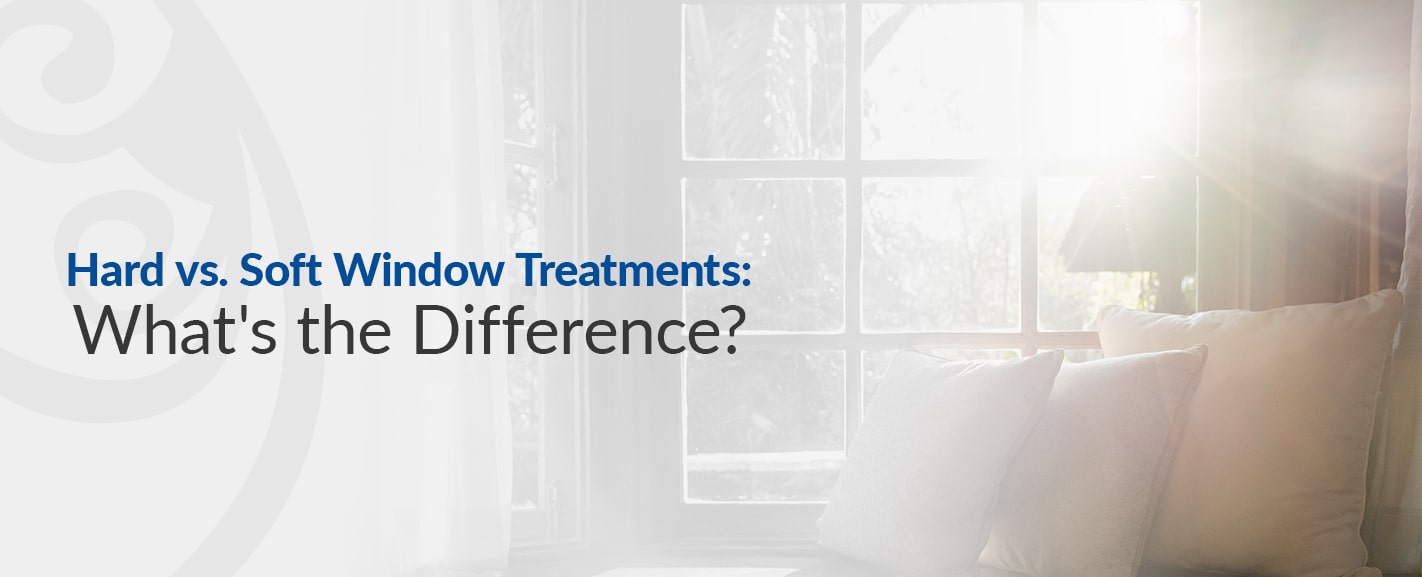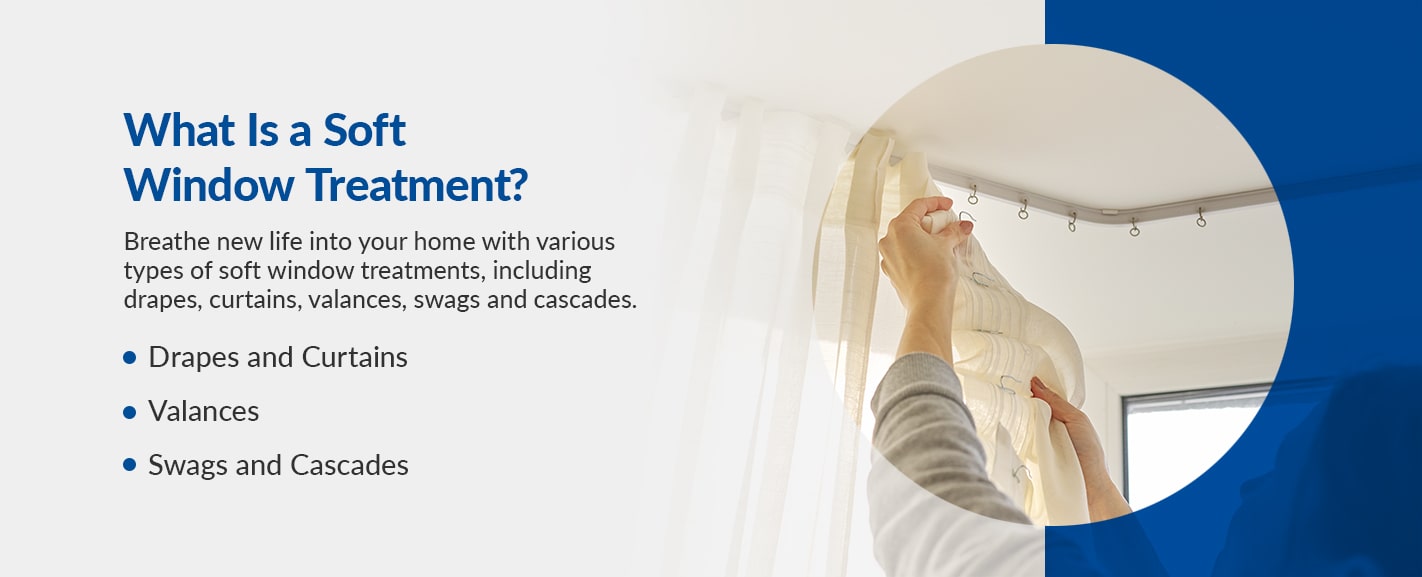Hard vs. Soft Window Treatments: What’s the Difference?
Table of Contents
- What Is a Hard Window Treatment?
- When to Use Hard Window Treatments
- What Is a Soft Window Treatment?
- When to Use Soft Window Treatments
- When to Combine Hard and Soft Window Treatments
- Ask the Professionals at Allure Window Treatments
Window treatments can add valuable function and aesthetics to every room of your house. Many homeowners use window treatments to create privacy, control light, maintain room temperatures, enhance the interior design and perform other essentials for a comfortable and efficient home.
Every room serves a unique purpose, so your window treatments should fulfill different goals throughout the house, too. You can use two types of window treatments separately or in combination to enhance your home’s value. Choose among hard and soft treatments for your windows to best complement each space.
What Is a Hard Window Treatment?
Hard window treatments are factory-made and typically installed for their range of functions and ease of use. While hard treatments sometimes consist of soft paper or cloth, most use more durable materials like wood or vinyl. Hard window treatments can provide a sleek, clean look ideal for virtually any interior design scheme.
Types of hard window treatments include shutters, blinds and shades.
Shutters
You can install interior shutters into the window frame with hinges, allowing you to open or shut them as desired. You can louver their horizontal slats for frequent adjustment or fix them at a set angle for total privacy.
Choose from louvers of various sizes for optimal control over the amount and direction of natural light that enters your home. The dovetail design used in many custom shutters can improve their strength and longevity, making them some of the most durable options available.
Benefits that you can expect from shutters include:
- Sunlight control.
- Increased privacy and security.
- Durability.
- Low maintenance.
- Protection against weather and other damages.
- Enhanced aesthetics.
Shutters generally consist of wood or plastic, which provide clean lines and unique style.
Blinds
Blinds offer versatile light blocking and privacy solutions to ensure absolute comfort inside your home. Homeowners can tilt the slats in either direction for a near 180-degree rotation. View beautiful landscapes with ease by adjusting the slats in unison or drawing them fully open.
Rich hardwood’s traditional styling may appeal to many homeowners, while metal blinds offer a sleek alternative for modern interior décor. Wood blinds are lightweight and durable, so you can maintain indoor temperatures with superior insulation. Resilient aluminum blinds are perfect for spaces affected by heat and moisture that could harm other materials such as flat plastic, fabric, embossed PVC or faux wood.
Consider different styles of blinds for the various rooms in your home.
- Venetian blinds: Slats suspended horizontally by tapes or cords rotate in unison to meet your specific needs — a classic choice for residential purposes.
- Vertical blinds: Slats rotate in unison, similar to Venetian blinds, yet hang vertically instead. They are less likely to collect dust, quicker to operate and ideal for expansive windows or patio doors.
- Room-darkening blinds: Horizontal blinds with smaller gaps and seams allow less light to penetrate, creating a private sanctuary.
Shades
The standard window shade is a continuous piece of fabric that rolls, stacks or folds as you adjust the height of the covered area. The wide selection of shades allows homeowners the flexibility of custom-made shades for virtually any window.
Horizontal shade options include the following.
- Cellular honeycomb shades: Cellular or “accordion” shades consist of lightweight paper or cloth materials and provide suitable all-around shading. Honeycomb shades offer outstanding insulation to boost your home’s energy efficiency.
- Roman shades: Sometimes considered a soft window treatment, Roman shades generally showcase unique fabrics and elegant layering. Soft folds and pleats crafted from various materials add visual appeal and texture to a room.
- Pleated shades: The pleated material pulls up to sit flat at the top of a window. They are discreet and give your room an uncluttered appearance.
- Solar and roller shades: These clean, smooth shades protect furnishings from the damaging effects of prolonged light exposure. While you must open other shades to look out at your surroundings, solar fabrics control sun glare and heat while maintaining your view of the outdoors in a closed position.
- Silhouette and pirouette shades: Whether they use motorized or manual operation, these types of shades reimagine how we control natural lighting. Silhouette and pirouette shades provide maximum discretion and unique visual appeal.
- Woven wood shades: Crafted from organic materials like wood, grass, bamboo and reeds, these meticulously woven shades add warmth and natural beauty.
Our vertical shade options include Vertiglide shades, Luminette privacy sheers and Skyline Gliding Window Panels. Blackout and room-darkening shades are also available in various styles for people who desire ultimate privacy and peaceful sleep. Light-filtering fabrics used on cellular, Roman and roller window shades give optimal UV control and temperature regulation.
When to Use Hard Window Treatments
When functionality is your top priority, start with hard window treatments. You may want to control light, create privacy, regulate temperature or frame a view — hard treatments can offer excellent solutions for these desires and more.
Custom hard window treatments are perfect for contemporary homes, yet can be suitable for traditional and elegant styles, too. Wood and bamboo create natural, architectural elements and add warmth throughout your home, while metal or plastic can look sleek and effortless in any space.
What Is a Soft Window Treatment?
Soft window treatments are made from soft materials and offer more variety for interior design purposes. Homeowners can select fabrics and textiles of various colors, textures, patterns, thickness and size for their treatments. Transform any room’s décor with perfectly matching design elements.
Breathe new life into your home with various types of soft window treatments, including drapes, curtains, valances, swags and cascades.
Drapes and Curtains
Drapescan cover the window or extend to the floor. Improve energy efficiency by lining the face fabric for further insulation and light-filtering properties. You can also choose your drapery panels’ sizing so they remain stationary on either or both sides of the window, serving a more decorative purpose instead.
The terms “curtain” and “drapery” often refer to the same type of window treatment. Curtains can be as long as drapes, though they can also be shorter than the window. For example, café curtains hang about halfway down from the top of the window. Both drapes and curtains can remain stationary, or you can draw them shut across a rod.
Valances
Valancesdecoratively cover the top of windows in various shapes and styles. Many homeowners use valances to hide other treatments’ frames and hardware, though you may opt to use them as a stand-alone decoration.
While most valances are soft treatments made of pleated, gathered or draped fabric, some can be hard window treatments made of wood components attached to the wall. Hard valances generally run straight across the top of the window, though they may have a carved bottom edge. Valances of any type provide a luxurious look at an affordable cost.
Swags and Cascades
Swags and cascades add visual appeal to your windows. They are primarily decorative and typically paired for a dynamic look.
Cascades, aka jabots or tails, fall from a drapery heading or valance to frame either side of the window in a loose, zig-zag pattern. Swags are a style of valance that drapes into soft, graceful folds. They can be stand-alone treatments or complement other aspects of the window.
When to Use Soft Window Treatments
Soft window treatments can perfectly match the décor already present in a room. Fabric elements offer more variety in the colors, patterns and textures you can use in your space, ensuring every room is unique. While some homeowners prefer hard treatments for bulk use throughout an entire house, rooms that see frequent use could benefit from custom soft treatments that captivate guests and tie an image together.
When to Combine Hard and Soft Window Treatments
Each room varies in purpose and will require custom window treatments to add the most value. Some rooms may even have multiple goals for your window treatments — functional and aesthetic. Create inviting areas that meet all your needs by combining window treatments.
You can achieve the following benefits with different mixtures of window treatment types.
- Aesthetics: Use soft window treatments as decoration on top of hard treatments for the style you desire. Layering soft treatments can add dimension and visual interest, hide frames and hardware or soften the appearance of the hard treatments underneath.
- Light control: Provide variations of light control for different times of the day. With multiple treatments, you can ensure light-filtering, room-darkening and blackout options are available when you need them. All three options offer valuable differences for light control and UV protection.
- Blackout: While many treatments offer blackout properties on their own, combining different methods will give you the best results. Blackout combinations will also improve your overall privacy and sound absorption.
- Energy efficiency: The average home loses about 30% of its heating energy through windows. Effective window treatments will reduce your energy loss and save on your heating and cooling bills.
- Ease of use: Motorized window treatments can improve your quality of life, changing how and when you use your windows. Automated blinds and shades provide many benefits, including convenience and simple operation.
Ask the Professionals at Allure Window Treatments
Find the perfect combination of window treatments for any room in your house with Allure Window Treatments. Our custom window treatment services provide solutions for various needs such as increased privacy, energy efficiency, room darkening and motorization.
Book a free in-home design consultation with Allure Window Treatments today, and one of our professional designers will help you design quality treatments that work for you. Whether you require hard treatments, soft treatments or a creative combination, we will guide you through all stages of the process from design to installation. Enhance your home with window treatments you love.[/vc_column_text][/vc_column][/vc_row]

Shani is the Marketing Director of Allure Window Treatments. She has over a decade of experience in the home improvement and window treatments industry.



Sorry, the comment form is closed at this time.